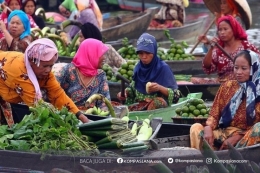Greetings Torch friends! This time Torch would like to share one of Indonesia's most unique tourist destinations in East Nusa Tenggara, the village of Wae Rebo. Located deep in the interior of Flores Island, this village holds a myriad of charms and uniqueness that are ready to delight the eyes while inviting us to explore the authentic culture of the Wae Rebo community up close. Explore further the excitement of vacationing in Desa Wae Rebo through the following Torch review!
History and Culture of Desa Wae Rebo
It is said that Desa Wae Rebo was founded by a man named Empu Maro who traveled all the way to Labuan Bajo. After living a nomadic life, Empu Maro finally decided to settle in the traditional village of Wae Rebo. The inhabitants of Wae Rebo Village still retain their Minangkabau ancestry as the village's founder, Empu Maro, originated from Sumatra Island. Currently, the inhabitants of Wae Rebo village have reached the 18th generation. The residents of Wae Rebo continue to be influenced by a strong cultural heritage and customs. They continue to uphold the traditions and ancestral rituals, one of which is the Penti ceremony, a ritual expressing gratitude for the harvest and the gift of life. Additionally, you can also interact directly with the locals to further explore the richness of other cultures.
Uniqueness and Attraction of Wae Rebo Village
The most distinctive feature of Wae Rebo is the cone-shaped traditional houses called Mbaru Niang. There are 7 Mbaru Niang, arranged in a circular formation around a central stone called compang. This company is commonly used by residents of Wae Rebo Village as a center for their activities such as ceremonies and customs.
Mbaru Niang has 5 levels with a roof made of palm leaves and covered with ijuk. Every detail and floor of the house serves a specific function that reflects the dynamics of daily social life in the Wae Rebo community, such as the ground floor being used to store harvest and food supplies. While the upper floor serves as a space for interaction and gathering, there is a separate floor designated for worship. Another uniqueness of Mbaru Niang is that it is built on the principle of not touching the ground to preserve its sacredness.
For the Manggarai tribe, the circle is considered a symbol of balance in life. Therefore, the concept of a circle is applied in almost all aspects of the village, ranging from settlement patterns to architectural structures.
In addition, the natural scenery surrounding the village is equally enchanting. Situated at an altitude of approximately 1,200 meters above sea level, the village of Wae Rebo is surrounded by beautiful green hills. The air is cool and fresh, as if inviting Torch's friend to momentarily breathe in the refreshing countryside air. It is no wonder that this village is often referred to as the "heaven above the clouds".
Exciting Tourism Activities in Wae Rebo Village
When visiting Wae Rebo, Torch friends can try various exciting tourism activities, such as:
Staying at the Traditional House
Visitors to the Wae Rebo village are enjoying a meal inside the traditional house.
Prepare yourself to experience the daily life of the local residents, as you can stay in a Wae Rebo traditional house for 1-2 days. Immerse oneself in the host's environment, savoring traditional cuisine, and gaining insight into their unique way of life and traditions. Observing the Penti Ceremony
The implementation of the Penti ceremony in the village of Wae Rebo attended by visitors
If fortunate, Torch friends can witness the annual ritual of the Penti ceremony. The sacred ceremony is an expression of gratitude for the abundant harvest, characterized by traditional dances and the ritual sacrifice of animals.
Writer by: https://www.kompasiana.com/sawang83283
Follow Instagram @kompasianacom juga Tiktok @kompasiana biar nggak ketinggalan event seru komunitas dan tips dapat cuan dari Kompasiana
Baca juga cerita inspiratif langsung dari smartphone kamu dengan bergabung di WhatsApp Channel Kompasiana di SINI







